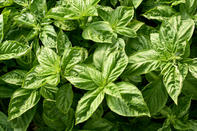
Scientific name: Ocimum basilicum
Common Name: Basil or Sweet Basil
The basil plant is thought to have originated in India. Today it is planted throughout the world for its fresh and dried leaves as well as its essential oils.
Plant Description
The basil bush grows to about 700 mm tall and has a herbaceous stem that hardens and becomes woody as the plant matures. The light green oval leaves are round at the base and are slightly pointed.
The leaves reach about 80 mm long and 30 to 50 mm wide. Some varieties have slightly red leaves. If the plant is allowed to grow to maturity white to lilac colour flowers will appear and go to seed.
Uses
Basil is cultivated for its aromatic leaves that are used fresh or dried and for the production of essential oils and essence. The fresh and dried leaves are used in cooking as flavouring and also eaten raw in salads.
Basil is known for its medicinal uses: relieving nausea, indigestion and inflammation. It is used to relieve anxiety as it has a slight sedative action. Basil has also been taken for migraines and said to help sufferers of epilepsy.
Soil Requirements and Preparation
Basil does best in well-drained sandy loam soils that are high in organic matter. It can grow in soils with a wide range in pH of 4.5 to 8 but does best in soils with a pH of 6.5.
When preparing the soil in the plant area it is essential to add enough organic manure or compost to the soil. This should be ploughed in a month before planting to give any weeds chance to germinate. The ground must then be disc harrowed in the week prior to planting to clear the weeds again and smooth the plant area.
Climate
Basil grows best in temperate climates in temperatures between 12°C and 28°C. It requires a germination temperature of over 20°C. The basil plant is sensitive to frost. Excessive heat or cold damages the basil plant and its very sensitive leaves.Cultivars
For commercial production, some popular cultivars are: Anise, Camphor, Cinnamon, Dani, Dark Opal, Genovese, Large leaf, Lemon, Mammoth, Purple ruffles and Sweet.
It is best to seek local advice on the growing practices and the seed company on what the best variety is for the intended market.
Do not plant anything unless the market for it is first known.
By Louise Brodie